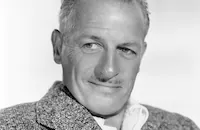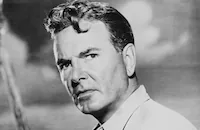Bulldog Drummond's Revenge

Brief Synopsis
Cast & Crew
Louis King
John Barrymore
John Howard
Louise Campbell
Reginald Denny
E. E. Clive
Film Details
Technical Specs

Synopsis
While Capt. Hugh "Bulldog" Drummond listens in, Sumio Kanda informs Colonel Nielson of Scotland Yard that an attempt will be made to steal the highly explosive substance "hextonite" in transit. The inventor of the substance insists on transporting the substance himself, accompanied by his secretary, Draven Nogais. During the flight, Nogais kills the inventor and parachutes the substance out of the plane. He then removes an already severed hand, places his ring on it, leaves it in the plane and parachutes out of the airplane. Drummond happens to drive by the plane crash and retrieves the case of hextonite and the severed hand before Nogais and his accomplice arrive. Drummond takes the evidence home and from the initials on the suitcase determines the owner, and also surmises that the severed hand is several days old and is probably a plant. Suddenly the lights go out and the suitcase is stolen. Drummond, his servant Tenny, his fiancèe Phyllis Clavering and his friend Algy Longworth all board a train at Victoria Station. Nogais is also on this train disguised as a woman, and has put the hextonite in a bottle of bath crystals. Drummond and Algy find the dead body of Nogais' accomplice and realize that Nogais must be on the train. They meet with Nielson on the Dover Ferry and discover Nogais' disguise. Nogais takes Tenny and Phyllis hostage in their own compartment, but Drummond comes in and takes control. An alarm clock goes off suddenly and in the confusion Nogais escapes. Nielson shoots Nogais before he can set off the explosives, and Algy catches the container of hextonite, thereby saving everyone's lives.

Director
Louis King
Cast

John Barrymore

John Howard
Louise Campbell

Reginald Denny

E. E. Clive

Frank Puglia
Nydia Westman
Robert Gleckler

Lucien Littlefield

John Sutton
Miki Morita
Bennie Bartlett
Matthew Boulton
Arthur Stuart Hull

Phil Smalley
Jimmy Aubrey
Gerald Rogers
Harold Entwistle
Winter Hall
Sidney Bracy
Brooks Benedict
Marie Burton
Ethel Clayton
Elsa Connor
Paula De Cardo
Joyce Mathews
Dorothy White
Gloria Williams
Harriette Haddon
Lola Jensen
Gwen Kenyon
Crew
John Cope
Hans Dreier
Harry Fischbeck
A. E. Freudeman
William Lebaron
Edward T. Lowe
Harry Mills
Boris Morros
Robert Odell
Arthur Schmidt
George Templeton
Stuart Walker
Adolph Zukor

Film Details
Technical Specs

Articles
Bulldog Drummond's Revenge
In 1937, Paramount began a run with the property with Bulldog Drummond Escapes, a January release starring Ray Milland as Drummond, Reginald Denny as sidekick Algy Langworth and Sir Guy Standing as Inspector Nielson of Scotland Yard. Its success prompted Paramount to continue with a B series of Drummond movies, and the studio got cracking on more scripts. Before their next title was ready, however, an unrelated British entry, Bulldog Drummond at Bay, was released in late July. The presence of American (John Lodge) and Canadian (Victor Jory) actors in the lead roles must have been a bit confusing to audiences -- a confusion exacerbated when Paramount's next film, Bulldog Drummond Comes Back, was released barely a month later with yet another actor, John Howard, as Drummond and John Barrymore taking over as Nielson. (Guy Standing had died suddenly in the interim.) Reginald Denny, however, did return as Algy, as did character actor E.E. Clive in the role of Tenny.
Paramount's next title, and the fourth of the year overall, was Bulldog Drummond's Revenge, released in mid-December. Now there was finally some continuity with Howard, Barrymore, Denny and Clive all reprising their roles. There would be five further films in the series, culminating with Bulldog Drummond's Bride (1939), and Howard, Denny, and Clive would appear in them all. Barrymore would be replaced after three films by H.B. Warner.
These films are squarely B productions, with running times of about an hour, shot cheaply and usually at night so as to get around the necessity of expensive art direction. They have their pleasures and the three with John Barrymore are perhaps the best. He was billed first in all three despite the fact that he doesn't even play the title role.
Barrymore's star had fallen dramatically in just a few years, with alcoholism, marital woes, and profligate spending taking a severe toll. (As film historian William K. Everson later wrote, "Seldom has any truly great star fallen so spectacularly as did Barrymore.") In 1937, pursued by the IRS, Barrymore was forced to declare bankruptcy and his lavish Beverly Hills estate -- with a skeet range, aviary, bowling green and over a dozen buildings -- was put up for auction. Barrymore was reduced to taking small roles in B films such as these Drummond pictures, and his memory problems necessitated the use of cue cards for his dialogue, but he worked diligently and responsibly as he strove to pay off his debts.
Bulldog Drummond's Revenge was based on McNeile's 1932 novel The Return of Bulldog Drummond, with the villain (Frank Puglia) trying to steal the formula of a new explosive. Reviews were mildly positive, with Variety noting the issue of Bulldog Drummond overload for moviegoers in recent months but still deeming the film "sufficiently exciting, with some comedy to spice and assist it over the usual bumps... The action and suspense maintain interest."
Following the Paramount series, Bulldog Drummond returned to the screen seven times over the next thirty years, with actors Ron Randell, Tom Conway, Walter Pidgeon, and Richard Johnson tackling the role.
By Jeremy Arnold
SOURCES:
William K. Everson, The Detective in Film
William K. Everson, program notes on Bulldog Drummond Comes Back
Michael A. Morrison, John Barrymore: Shakespearean Actor
Michael R. Pitts, Famous Movie Detectives
Robert J. Wagner with Scott Eyman, You Must Remember This

Bulldog Drummond's Revenge
Quotes
Trivia
Notes
For additional information on the Bulldog Drummond character, see the entries for Bulldog Drummond Escapes and Bulldog Drummond Strikes Back and consult the Series Index.














